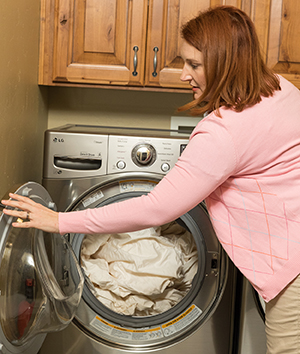For many people with lung problems such as asthma or COPD, breathing in allergens leads to inflamed airways. Allergens also cause other types of reactions in some people. For example, a runny nose, itchy, watery eyes, or a skin rash. Do your best to stay away from allergens that trigger symptoms. The tips below can help reduce any reaction you may have to certain allergens.
Dust mites
Dust mites are tiny bugs too small to see or feel. Dust mites are not parasites. They do not bite, but they can be a major trigger for allergy and asthma symptoms. Dust mites live in mattresses, bedding, carpets, and upholstered furniture. They can be carried on indoor dust. They thrive in warm, moist environments.
-
Wash bedding in hot water (130°F/54.4°C) each week. This kills the dust mites.
-
Cover mattresses and pillows with special dust-mite-proof (hypoallergenic) cases.
-
Don’t use upholstered furniture such as sofas or chairs in the bedroom. Use leather or wood instead.
-
Use allergy-proof filters for air conditioners and furnaces. Follow product maker's instructions for maintaining and replacing filters.
-
Dust furniture in your bedroom regularly.
-
If you can, replace wall-to-wall carpets with wood, tile, or linoleum floors. This is very important in the bedroom.
Animals
Animals with fur or feathers make allergens in their skin cells and saliva. These are shed as tiny particles called dander. Dander can float through the air. Or it can stick to carpet, clothing, and furniture. Contrary to popular belief, there are no "hypoallergenic" dogs or cats.
-
Choose a pet that doesn’t have fur or feathers. Examples are fish and reptiles.
-
Keep pets with fur or feathers out of your home. If you can’t do this, keep them out of your bedroom. But keeping a pet out of your bedroom doesn't mean your bedroom is free of pet allergens. If you sit on the couch in the living room and then go into your bedroom, you have brought the pet allergen there.
-
Wash your hands and clothes after handling pets.
-
Give your pet a bath each week to decrease the amount of allergens.
-
Avoid contact with soiled litter and cages as much as possible.
Mold
Mold grows in damp places, such as bathrooms, basements, and closets. It can grow anywhere that flooding or a fire has caused water damage. Mold can live behind the walls if there has been water damage.
-
Clean damp areas weekly to prevent mold growth. This includes shower stalls and sinks. You may need someone to clean these areas for you. Or try wearing a mask.
-
Run an exhaust fan while bathing. Or leave a window or door open in the bathroom.
-
Repair water leaks in or around your home.
-
Have someone else cut grass or rake leaves, if possible.
-
Don’t use vaporizers or humidifiers. These put water into the air and encourage mold growth.
Pollen
Pollen from trees, grasses, and weeds is a common allergen. Flower pollens are generally not a problem.
-
Try to learn what types of pollen affect you most. Pollen levels vary depending on the plant, the season, and the time of day.
-
Use air conditioning instead of opening the windows in your home or car. In the car, choose the setting to recirculate the air so that less pollen gets in.
-
Have someone else do yard work, if possible.
-
If you are highly allergic to pollens, keep track of pollen counts by checking weather and pollen trackers. On days with high pollen counts, change your clothes and shower when you come inside to clean off the pollens once you are home.
Cockroaches and mice
Cockroaches and mice are common household pests. They also produce allergens.
-
Keep your kitchen clean and dry. A leaky faucet or drain can attract roaches.
-
Remove garbage from your home daily.
-
Store food in tightly sealed containers. Wash dishes as soon as they are used.
-
Use bait stations or traps to control roaches. Don't use chemical sprays.
Featured in


